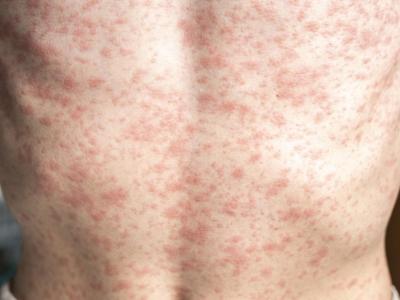Flu vaccine in Canada shows strikingly low effectiveness
This flu season's vaccine has provided "little or no protection" against influenza in Canada because of a mismatch between the H3N2 strain included in the vaccine and the predominant circulating H3N2 strain, say interim findings from the Canadian Sentinel Physician Surveillance Network (SPSN) published in today's issue of Eurosurveillance.
The study population comprised 861 patients who presented to community-based practitioners within a week of onset of influenza-like illness (ILI) over the period from Nov 3, 2014, through Jan 19 of this year. Of those, 410 (48%) tested positive for flu, and 451 (52%) tested negative. The proportions of cases and controls who had been vaccinated against flu at least 2 weeks before onset of ILI were not significantly different (35% and 33%, respectively).
Among the flu case-patients, 379 of the 381 (99%) for whom subtyping was available had type H3N2 viruses. Of 226 H3N2 viruses that were sequenced, 205 (91%) were considered antigenically distinct from the vaccine strain.
Adjusted vaccine effectiveness (VE) against medically attended H3N2 infection, was found to be –8% (95% confidence interval [CI], –50% to 23%). This compares with a midseason VE of 23% in the United States, reported recently by the Centers for Disease Control and Prevention..
The researchers note that the VE they report is the lowest of any seasonal strain over the past 10 years, and they call the contrast with last year's midseason VE of 74% (CI, 58% to 83%) against the dominant 2009 pandemic H1N1 strain "striking."
Regarding this season's flu, they conclude, "Given limited vaccine protection, other adjunct protective measures should be considered to minimize associated morbidity and mortality, particularly among high-risk individuals."
Jan 29 Eurosurveillance article
Jan 15 CIDRAP News story on US VE
WHO: No genetic changes seen in Egypt's H5N1 surge
The World Health Organization (WHO) yesterday commented on reports of 24 new H5N1 avian influenza cases it has received from Egypt since its last update on Jan 6, saying that no major genetic changes in the virus have been seen. Eleven of the infections were fatal.
Seven of the 24 cases had onsets in December and 17 had January onsets. The newest cases were reported in nine different governorates, with one cluster involving two siblings from Assiut governorate. The case-patients both got sick on the same day and had been exposed to backyard poultry.
Health officials found that 21 of the patients had a history of exposure to poultry or poultry markets, and the sources of infections are still under investigation for the other three people.
Egypt's count of H5N1 infections in December was the highest reported for a single month by any country, according to the WHO. It added that though all flu viruses evolve over time, preliminary lab investigation of isolates from animals and people haven't found any major genetic changes.
The reason for Egypt's large spike in cases is probably related to several factors, which could include increased H5N1 circulation in poultry, lower awareness of disease risks in some areas of Egypt, and seasonal factors such as contact with poultry in cold weather conditions that may favor virus survival in the environment.
Further investigations are under way to explore the viruses and the epidemiology of the infections, the WHO said.
With the 24 Egyptian cases added, the global H5N1 total is 718 cases, 413 of them fatal, the WHO said.
The H5N1 cases included in the WHO report are those reported by Egypt through Jan 26. Since then the country's health ministry has reported three more cases, one of them fatal, according to other reports.
Several other avian flu subtypes have been detected recently in many countries, including H5N2, H5N3, H5N6, and H5N8. The WHO said that though H5 viruses have the capacity to cause disease in humans, so far no infections with the subtypes have been found, except for two H5N6 illnesses in China in 2014.
Jan 26 WHO influenza at the animal-human interface update
H7N9 hospitalizes three more in China
For the seventh day in a row, China's Guangdong province reported more H7N9 avian influenza cases, in three adults from different locations, according to a report today from Hong Kong's Centre for Health Protection (CHP).
The patients include two men, a 21-year-old from Shenzhen and a 59-year-old from Meizhou. Both are hospitalized in stable condition. The third patient is a 42-year-old woman from Foshan who is hospitalized in critical condition.
Today's illnesses lift the global H7N9 total to 538 cases, according to a case list kept by FluTrackers, an infectious disease news message board.
The WHO yesterday said its Pan American Health Organization (PAHO) office had received a report from Canada about its recent H7N9 case, in a British Columbia woman who got sick after returning from China. The agency said that since March 2013 it had received reports of nearly 500 cases, 138 of them fatal. It reiterated that most cases are linked to poultry or their environments, including live markets, and that the virus doesn't pass easily from person to person.
The WHO added that it is monitoring the situation closely and is conducting risk assessments about the possibility of more human cases.
Jan 29 CHP statement
FluTrackers H7N9 case list
Jan 28 PAHO statement
CDC installs cameras in high-containment labs
In the wake of several recent lab safety problems, the US Centers for Disease Control and Prevention (CDC) has started monitoring its high-containment labs with cameras, Reuters reported today.
The story said 67 cameras have been installed in key laboratories to ensure that technicians follow established safety procedures, especially when taking steps to inactivate dangerous pathogens so that workers can study them in lower-containment facilities.
Leslie Dauphin, PhD, the CDC's interim director of lab safety, told Reuters that the step will allow lab directors and senior scientists to make sure that workers have adhered to protocols.
In the most recent incident, the CDC revealed that a lab worker had handled a live Ebola virus that was meant to have been inactivated. Dauphin told Reuters that no infections were detected, and the CDC expects to release the results of its internal investigation of the incident within the next week.
Jan 28 Reuters story










